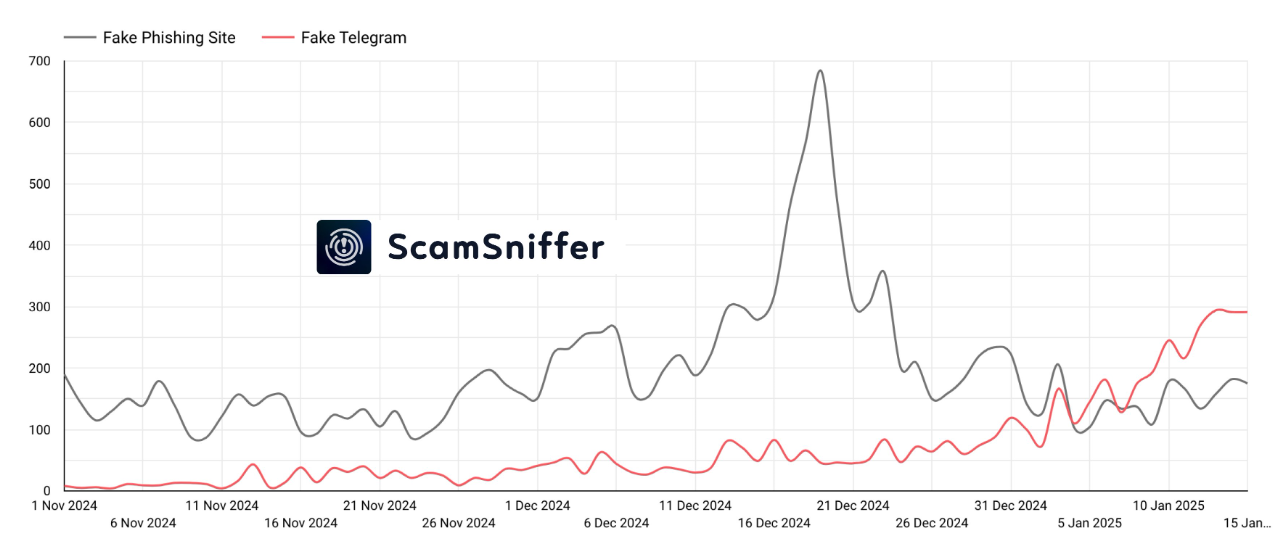Scam Sniffer revealed that crypto phishing scams on Telegram have skyrocketed by over 2,000% since November 2024, marking a shift toward sophisticated malware-driven tactics.
The surge in malicious activities highlights growing risks in crypto communities relying on the platform.
Telegram Crypto Phishing Scams On The Rise
Scam Sniffer’s data, shared on X (Twitter), reveals that Telegram scams now surpass traditional phishing in prevalence. While regular phishing attacks have remained stable, malicious Telegram group scams have exploded, exposing users to unprecedented risks.
 Telegram Malware Scams vs Traditional Phishing. Source: Scam Sniffer Post on X
Telegram Malware Scams vs Traditional Phishing. Source: Scam Sniffer Post on XCiting a new breed of swindles, the security researcher notes that, unlike typical “connect wallet” phishing schemes, these Telegram-based scams employ more sophisticated methods. Specifically, Scam Sniffer cites:
- Fake Verification Bots: Disguised as security tools, these bots trick users into executing malicious commands.
- Fake Trading and Airdrop Groups: These groups lure victims with promises of exclusive investment opportunities or free crypto.
- “Exclusive” Alpha Groups: Impersonating crypto influencers, scammers create urgency to bait victims.
Once victims engage with the scams — whether by executing code or installing “verification” software — they risk exposing their sensitive information. This includes passwords, wallet files, browser data, and even clipboard activity, all of which can be exploited to steal cryptocurrency.
The shift in tactics comes as users grow more cautious of signature scams and phishing links. According to Scam Sniffer, the malware offers attackers broader access and makes tracking losses significantly harder. Against this backdrop, the researcher warns that this evolution represents a troubling trend in crypto scams.
To combat these threats, Scam Sniffer advises avoiding running unknown commands or executing scripts from untrusted sources. He also cautions against installing unverified software promoted in Telegram groups.
“No legitimate crypto service will ever ask you to execute commands, install verification software, or run scripts from your clipboard,” Scam Sniffer reiterated.
The anti-scam platform also advocates the use of hardware wallets, which provide an extra layer of security by keeping private keys offline.
Telegram’s Role Under Scrutiny
The rise in Telegram malware scams coincides with other notable trends in crypto fraud. Security firms are identifying Telegram channels promoting fraudulent activities, further underlining the platform’s vulnerabilities.
Scammers are also impersonating crypto influencers, inviting users to “exclusive” Telegram groups. A December post by Scam Sniffer detailed how these groups use fake verification bots to inject malicious PowerShell code into victims’ systems.
“New sophisticated scam targeting crypto users through fake Telegram groups. Attackers are impersonating multiple crypto influencers and using malicious bots for verification,” Scam Sniffer said.
Telegram has faced criticism for its approach to handling crypto scams. In Spain, the platform was temporarily suspended following complaints from media companies about its role in facilitating scams and piracy. Meanwhile, a user on X expressed frustration over the platform’s inadequate efforts to curb such activities.
Concerns about Telegram’s oversight have intensified following the recent arrest of its CEO, Pavel Durov, in France. Durov was accused of complicity in enabling illicit transactions linked to organized crime activities conducted through Telegram.
He shared that authorities warned he could be held personally liable for illegal activities happening on Telegram because of the platform’s lack of action.
The issue, however, hasn’t gone away. Telegram malware scams continue to grow, making it clear that users need to stay alert. With the platform under increased scrutiny and scams becoming more common, crypto users need to be more cautious than ever.
The post Crypto Phishing on Telegram Surged 2,000% Since November 2024: Scam Sniffer appeared first on BeInCrypto.

 9 months ago
61
9 months ago
61




 English (US) ·
English (US) ·